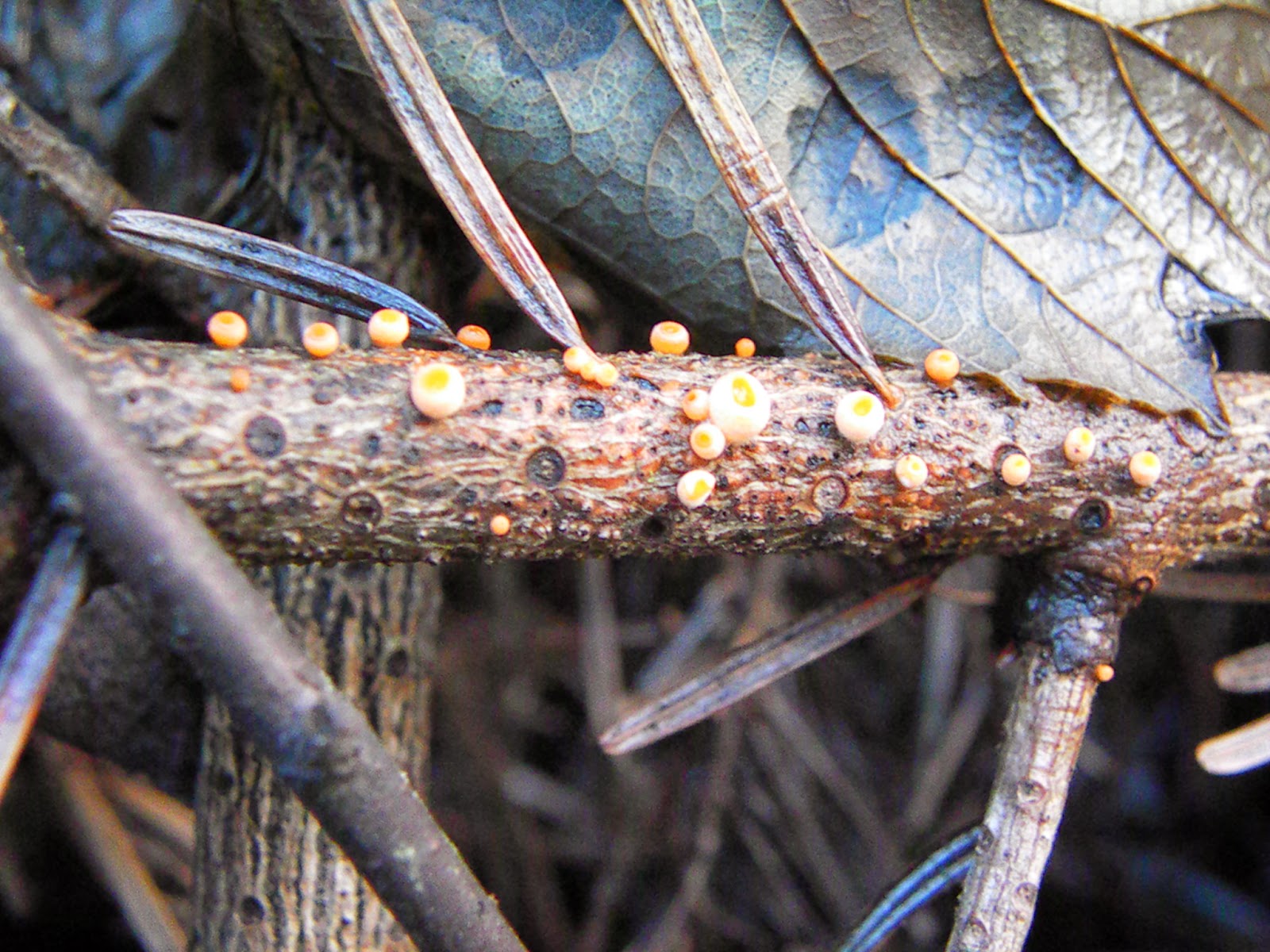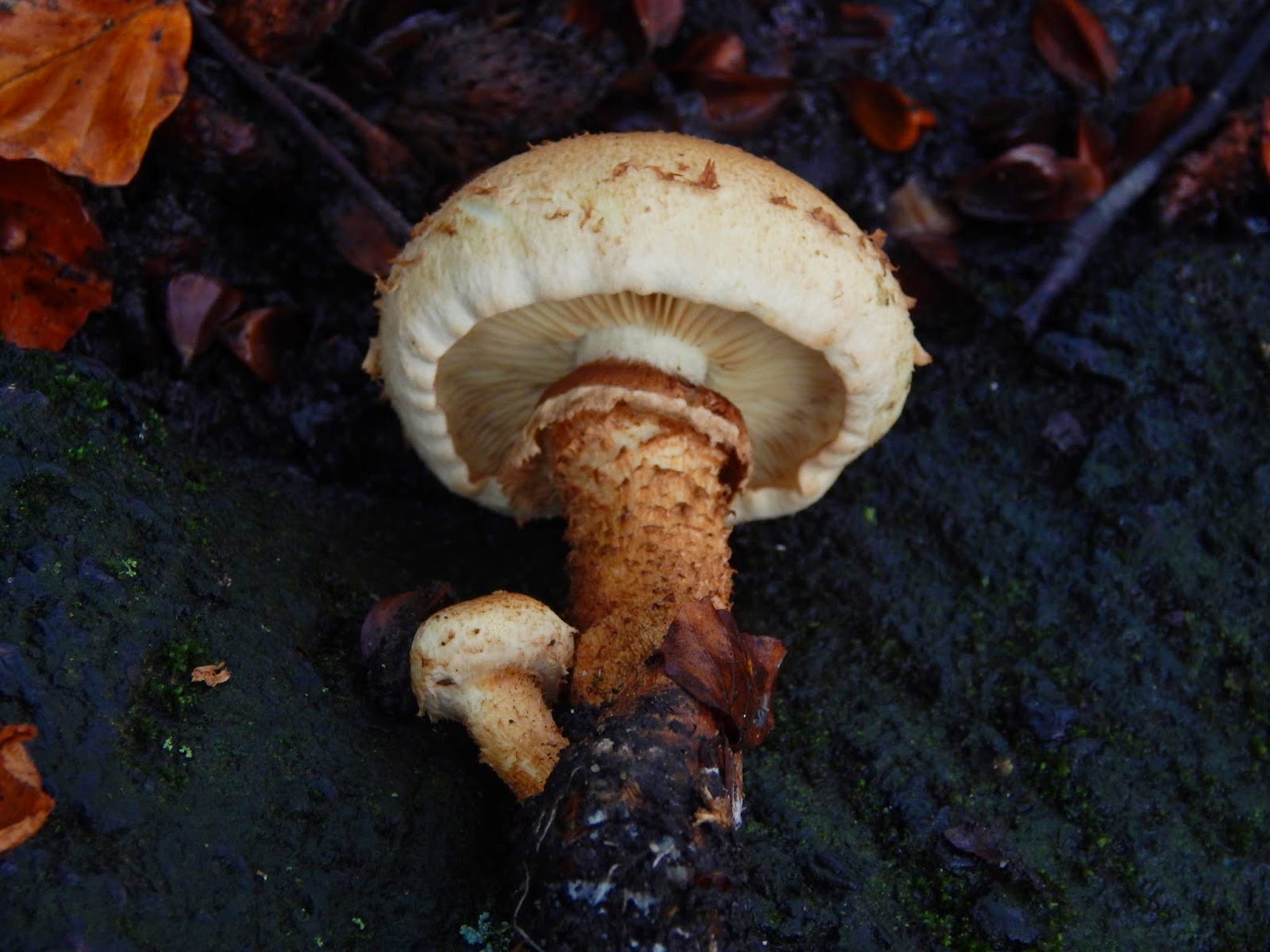I've been so busy with work that I've had very little time to foray lately and post my finds on here.
I visited Ogden a few times in November and always managed to discover something along the way.
My fungus of the year was the Herald of Winter (Hygrophorus hypothejus) as Michael set me the task of finding it three years ago and now my search is finally over.
Variable Oysterling (Crepidotus variablis) above and below.
Found growing in abundance on dead herbaceous stems.
Spores amygdaloid, 5.5-6.6 x 3-4 microns.
Clavate, branched cheilocystidia
Deer Sheild (Pluteus cervinus) above and below.
Horned cheilocystidia.
Spores ellipsoid 6-8 x 4-6 microns.
Conifer Tuft (Hypholoma capnoides).
Unlike Hypholoma fasciculare, it has pale grey gills.
Common Rustgill (Gymnopilus penetrans).
Purplepore Bracket (Trichaptum abietinum) growing from a dead pine log.
They don't look very pretty when you look at the caps but the porous, fertile surface is a very beautiful colour.
Silverleaf Fungus (Chondrostereum purpureum).
In comparison to Trichaptum abietinum, this has a smooth, fertile under surface.
Root-Rot (Heterobasidion annosum).
Herald of Winter (Hygrophorus hypothejus).
First seen on the 1st November when Peachysteve and I led a foray with Ogden Wildlife WATCH group with Robin Dalton and Chris Sutcliffe.
I remember when Oliver and myself joined the HSS and Michael said to me "I've got one for you to find" and it was this.
So, I've spent the last three years, trudging around in coniferous woodland trying to find it.
When I first laid my eyes on it I didn't even recognize it!
The stipe is so slippery that you have trouble picking it up.
Seen again on the 18th November in a different location (above) and on the 27th of November in a different part of the wood with Michael (below).
Michael's photograph.
Spores 6.6-9.35 x 4.5-5 microns.
Shaggy Scalycap (Pholiota squarrosa) above and below.
Purple Jellydisc (Ascocoryne sarcoides) above and spores below.
Olive Oysterling (Sarcomyxa serotina) above and showing the lovely orange gills below.
Elastic Oysterling (Panellus mitis) above and below.
Thanks to Fungorum (Dave) for the identification.
It was very rubbery and had a tough, gelatinous, cap cuticle.
Ergot (Claviceps purpurea) on dead Purple Moor Grass (Molinia caerulea) spikelets.
White Brain (Exidia thuretiana).
Clustered Toughshank (Gymnopus confluens).
Cheilocystidia knobbly, +/- lobed and wavy.
Spores tear shaped, 6-9 x 2.5-4 microns.
Conifercone Cap (Baeospora myosura).
Michael's photograph.
These were popping up everywhere and I've never seen as many specimens in the same location, it was crazy.
Cheilocystidia clavate to fusiform without crystals.
Spores amyloid, ellipsoid, 3-4.5 x 1.5-2 microns.
Snakeskin Brownie (Hypholoma marginatum).
Yellow Stagshorn (Calocera viscosa).
Mealy Bonnet (Mycena cinerella) found growing from rotting, coniferous needle litter.
Cinnamon Webcap (Cortinarius cinnamoneus) above and below.
Leafy Brain (Tremella foliacea).
Michael and I found this species of fungus but it has completely flummoxed us.
It was in a group of five, all identical. Cap 1.5 cm, white and matt. White, adnate gills.
Pink, floccose stem, 2.75 cm, arising from a soft, bulbous, mycelial base.
We have never seen anything like it before and we have absolutely no idea what it is.
We did go back another day to try and find some more but we couldn't see any.
Michael's photograph above and mine below. One suggestion of mine is that they may have been introduced from spores on the recycled Christmas trees that surround the edge of the reservoir?
If anyone has any ideas please leave a comment.
Spore print pink/orange. Spores pip shaped/amygdaloid, rough/warty, 4.5-5.5 x 3.5 microns.





















.jpeg)
.jpeg)

.jpeg)
.jpeg)

.jpeg)




.jpeg)
.jpeg)
.jpeg)
.jpeg)
.jpeg)

.jpeg)
.jpeg)






.jpeg)
.jpeg)


.jpeg)








.jpeg)
.jpeg)
.jpeg)
.jpeg)

